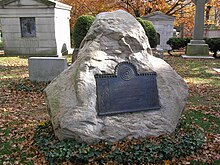Noguchi Hideyo
Noguchi Hideyo ( Jap. 野口英世 ) - also Seisaku Noguchi (野口清作Noguchi Seisaku) - (* 9. November 1876 in Sanjogata at Okinashima (翁島村) / Okinashima- mura , today Inawashiro properly, Fukushima prefecture on Honshu / Japan ; † May 21, 1928 in Accra , Ghana ) was a Japanese medic and microbiologist .
Life
Noguchi came from a poor farming family. At the age of one and a half he fell into the fireplace and burned his left hand, which was henceforth crippled. The surgical treatment of a burn brought him into contact with the world of medicine as a child. Since he was no longer suitable for the hard work in the country due to his handicap, his mother Shika tried to train as a doctor. From 1893 he studied medicine at the Nihon Ika Daigaku and was licensed as a doctor at the age of 20. In 1900 he accepted an invitation from Simon Flexner and began research on snake venom at the University of Pennsylvania . From 1904 he worked at the Rockefeller Institute for Medical Research , where he announced in August 1911 that he had succeeded in breeding spirochetes , the causative agents of syphilis . This pure breed could not be reproduced by other researchers. The detection of spirochetes in the brain tissue of patients suffering from progressive paralysis , which he succeeded in 1913, was groundbreaking . In February 1914 he reported on the experimental evidence of the connection with the disease. The evidence of polio and rabies pathogens he published later turned out to be false. He was nominated for the Nobel Prize for Medicine in 1914 and 1915 .
When he returned to Japan in September 1915, he was received with stormy jubilation by the public, but was met with cool rejection from his Japanese colleagues. In 1918 he traveled to Ecuador on behalf of the Rockefeller Foundation to research a vaccine against yellow fever . A few days after his arrival there, he believed he had discovered the pathogen causing yellow fever. The spirochetes described by Noguchi may have been the causative agent of Weil's disease . In 1927 he was elected a member of the Leopoldina .
After Noguchi's treatment method, which had been tried out in Ecuador, had proven to be a failure in West Africa in 1927, he decided in 1928 to set up a laboratory in Accra ( Ghana ) to research yellow fever. While doing research with rhesus monkeys , Noguchi infected himself with the yellow fever virus and died of this tropical disease. A portrait of Noguchi can be found on the new 1000 yen note that the Bank of Japan has been issuing since the end of 2004.
In 2006, the Japanese government founded the Noguchi Hideyo Africa Prize for outstanding achievements in the field of medicine and infectious diseases.
literature
- Barbara I. Tshisuaka: Noguchi, (Seisaku) Hideyo. In: Werner E. Gerabek , Bernhard D. Haage, Gundolf Keil , Wolfgang Wegner (eds.): Enzyklopädie Medizingeschichte. De Gruyter, Berlin / New York 2005, ISBN 3-11-015714-4 , p. 1055.
Web links
- Hideyo Noguchi . Encyclopædia Britannica Online. Encyclopædia Britannica, 2011.
Remarks
- ↑ See also JG Sleeswijk: The Serodiagnostik der Syphilis nach Noguchi. In: German Medical Weekly . Volume 36, 1910, pp. 1213-1215.
- ↑ Ernst Bäumler: Paul Ehrlich. Researcher for Life. 3. Edition. Frankfurt am Main 1997, p. 281.
| personal data | |
|---|---|
| SURNAME | Noguchi, Hideyo |
| ALTERNATIVE NAMES | 野 口 英 世 (Japanese) |
| BRIEF DESCRIPTION | Japanese bacteriologist |
| DATE OF BIRTH | November 9, 1876 |
| PLACE OF BIRTH | Inawashiro , Fukushima Prefecture |
| DATE OF DEATH | May 21, 1928 |
| Place of death | Accra |

